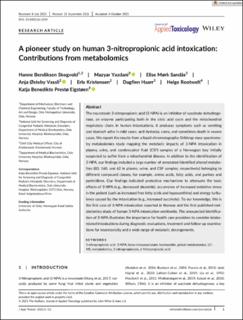| dc.description.abstract | The neurotoxin 3-nitropropionic acid (3-NPA) is an inhibitor of succinate dehydrogenase, an enzyme participating both in the citric acid cycle and the mitochondrial respiratory chain. In human intoxications, it produces symptoms such as vomiting and stomach ache in mild cases, and dystonia, coma, and sometimes death in severe cases. We report the results from a liquid chromatography-Orbitrap mass spectrometry metabolomics study mapping the metabolic impacts of 3-NPA intoxication in plasma, urine, and cerebrospinal fluid (CSF) samples of a Norwegian boy initially suspected to suffer from a mitochondrial disease. In addition to the identification of 3-NPA, our findings included a large number of annotated/identified altered metabolites (80, 160, and 62 in plasma, urine, and CSF samples, respectively) belonging to different compound classes, for example, amino acids, fatty acids, and purines and pyrimidines. Our findings indicated protective mechanisms to attenuate the toxic effects of 3-NPA (e.g., decreased oleamide), occurrence of increased oxidative stress in the patient (such as increased free fatty acids and hypoxanthine) and energy turbulence caused by the intoxication (e.g., increased succinate). To our knowledge, this is the first case of 3-NPA intoxication reported in Norway and the first published metabolomics study of human 3-NPA intoxication worldwide. The unexpected identification of 3-NPA illustrates the importance for health care providers to consider intakerelated intoxications during diagnostic evaluations, treatment and follow-up examinations for neurotoxicity and a wide range of metabolic derangements. | en_US |

